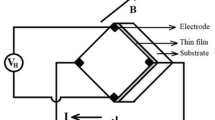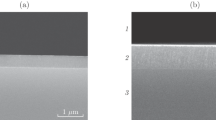Abstract
Rapid thermal annealing of amorphous tungsten silicide thin films (W0.62 Si0 38) on Si at 1100°C in Ar and N2 ambient gases was studied. All films annealed in N2 exhibited good adhesion and remained smooth with no large grain growth. Films annealed in Ar showed grain nucleation and growth from the film perimeter until a critical stress was achieved, followed by stress-assisted grain growth. The resulting growth of large columnar grains caused the films to delaminate. Removal of the surface oxide/nitride layer from the silicide prior to annealing resulted in uniform nucleation and growth over the entire film during annealing in Ar, with no stress-assisted grain growth or film delamination. No difference, however, was observed during annealing in N2. These results suggest that a surface film produced during annealing in N2 slows the nucleation and growth and consequently enhances film adhesion.
Similar content being viewed by others
Author information
Authors and Affiliations
Rights and permissions
About this article
Cite this article
Smith, P.M., Thompson, M.O. The Effects of N2 and Ar as the Ambient Gas During Rapid Thermal Annealing of Tungsten Silicide. MRS Online Proceedings Library 100, 707 (1987). https://doi.org/10.1557/PROC-100-707
Published:
DOI: https://doi.org/10.1557/PROC-100-707




